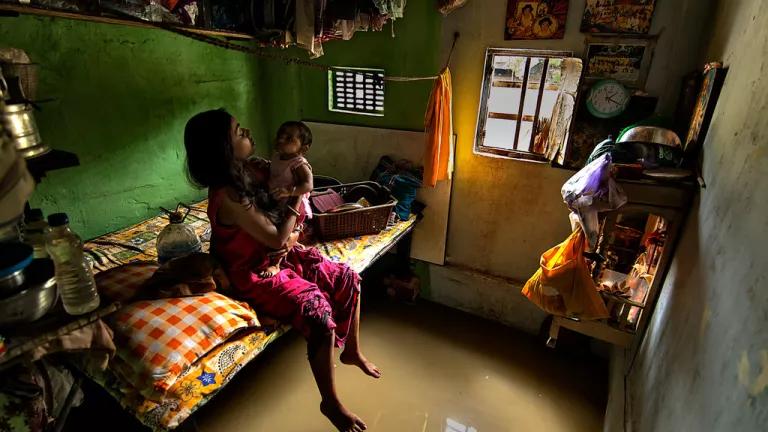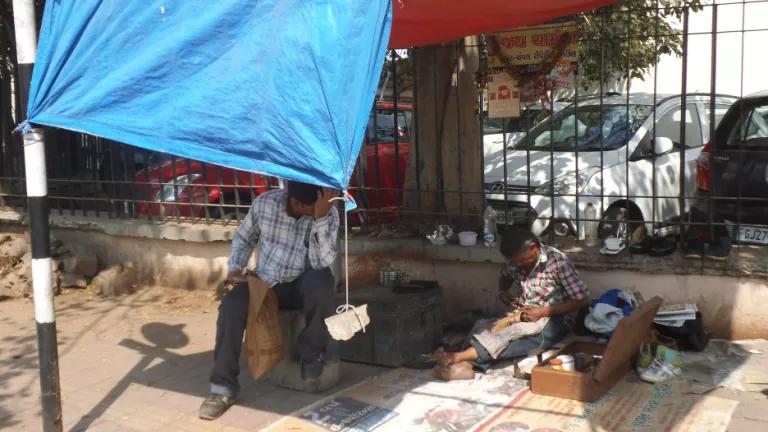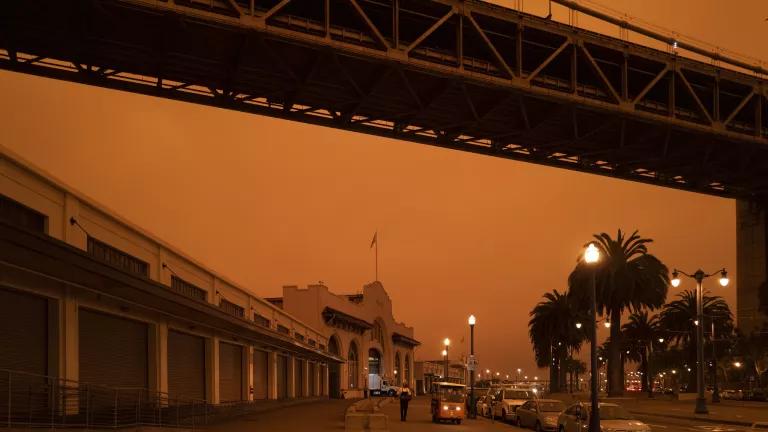How to Survive and Thrive on a Hotter Planet
This week’s IPCC report makes it clear that heat waves will continue to worsen—so we must rise to the challenge of living with extreme heat events.

A woman rests in the shade at an unhoused resource center on a record-breaking 116-degree day in Las Vegas on June 16, 2021.
Average global temperatures rose faster during my lifetime than any period in at least the last 2,000 years, according to the Intergovernmental Panel on Climate Change’s (IPCC) latest assessment of how and why our climate is changing. As average temperatures have increased, largely due to the burning of fossil fuels, so, too, have dangerous heat extremes like those in the Pacific Northwest, Colorado, and Maine. The IPCC warns that unhealthy heat events will continue to worsen for decades in the United States, even if nations aggressively limit climate-changing pollution.
That’s bad news for our health. Heat stress can lead to death from more than two dozen conditions, including heat stroke, kidney disease, heart attacks, and lung damage. Even when heat-related illnesses aren’t deadly, they can take people out of commission for days or weeks at a time, potentially leading to costly medical bills or permanent disability.
It's discouraging to think about things getting worse before they get better. But critically, our responses to climate-fueled extremes are even more important than the extremes themselves.
Here are just a few ways we can rise to the challenge of a hotter world.
Affordably and efficiently cool our homes
A stunning number of heat-related deaths each year happen inside buildings. In Oregon’s Multnomah County, for example, all but 2 of 54 people who died of confirmed heat-related causes during the June 2021 heat dome were in their homes. Roughly half of those people didn’t have air-conditioning units.
But even people with AC units might not use them, especially if they face a choice between paying for electricity or home maintenance, and paying for food. In 2020, 82 percent of indoor heat deaths in Maricopa County, Arizona, occurred in places with AC. The units were functional but not turned on in about a third of those cases and nonfunctional in the rest.
One of the most important solutions to this problem is lifting the burden on Black, Latino, and low-income households that spend a disproportionate amount of their income on energy. Policies that increase access to AC include home energy assistance programs, protections against cost increases on electric bills, and creating more affordable housing.
Of course, air-conditioning that runs on fossil fuels contributes to global heating and local increases in unhealthy soot and smog. That’s why it’s also essential to ensure our buildings and appliances are highly efficient and powered by clean electricity.

Cyclists in the East Harlem neighborhood of New York City
Equitably cool our neighborhoods
You don’t need to be a scientist to know that a shady, treelined street is cooler than one with sun-blasted asphalt and concrete in every direction. Multiple studies have shown that low-income communities and communities of color have less green space than wealthier, whiter communities—and average temperatures more than 3.5° Fahrenheit higher as a result.
Much of that pattern is related to racist housing and land use practices such as redlining. Decades of segregation and disinvestment have pushed low-income people of color into hotter areas and denied them the resources needed to plant and maintain street trees and other vegetation. One solution that would start to address this disparity is the SHADE Act. Introduced in the House of Representatives earlier this year, the SHADE Act directs the U.S. Department of Housing and Urban Development (HUD) to establish a grant program for tree planting in formerly redlined and other overburdened neighborhoods.
Urban greening’s many benefits can unfortunately increase property values and rent, making neighborhoods unaffordable for lower-income residents and leading to displacement. However, there are key policies that can reduce the risks of “green gentrification.” Increasing green space, whether tree planting or other development, must be paired with community-led and community-supported policies on equitable housing and community stabilization.

Workers on a farm under extreme heat conditions near St. Paul, Oregon, on July, 1, 2021
Keep workers safe
Most new details from the IPCC on how climate change affects our health, economy, and the natural world will come in a future report. However, it’s telling that one of the few societal impacts explicitly mentioned in this week’s report is the effect of heat on labor productivity.
Extreme heat can slash productivity through illnesses and injuries, increases in safety precautions, such as breaks, and reduced operating hours. In 2019, the U.S. service, manufacturing, agricultural, and construction sectors lost more than two billion potential work hours to extreme heat. These losses can have ripple effects on health for small-business owners operating on the economic margin and low-wage workers without paid time off.
There are currently no federal standards—and very few state standards—to explicitly protect workers from the growing threat of extreme heat. The Asunción Valdivia Heat Illness and Fatality Prevention Act, which has been repeatedly introduced in the House and Senate, directs the U.S. Occupational Safety and Health Administration to establish such an enforceable heat safety rule. The bill includes whistleblower protections for workers who report dangerous conditions—a critical safeguard for people who fear they’ll get fired for something as simple as a water break.
Aggressively cut carbon pollution
Although we have a lot of tools to protect people from heat, the problem gets harder to solve the hotter the world gets. According to the IPCC report: "With every additional increment of global warming, changes in extremes continue to become larger. For example, every additional 0.5° Celsius of global warming causes clearly discernible increases in the intensity and frequency of hot extremes, including heat waves.”
Every tenth of a degree matters when it comes to the health risks of heat. Avoiding half a degree Celsius (0.9° F) of average warming could mean 38 percent fewer heat-related health harms globally, not to mention fewer illnesses and deaths from more severe wildfires, hurricanes, floods, and other climate change–fueled extremes.

A Pacific Power employee directing traffic on Route 22 in Oregon, surrounded by wildfire smoke
Congress and the Biden administration need to get serious about transforming our economy to one that, you know, won’t kill us. Immediate steps include delivering on the promise of President Biden’s Build Back Better agenda, which could put the United States on a path to cut carbon pollution in half by 2030.
Make no mistake: The IPCC report is a dire warning about where we’re headed in the absence of strong, committed action to cut carbon pollution and prepare our communities for a hotter and more dangerous future. But all is not lost. With appropriate planning and investment, we can provide immediate relief to people suffering from climate change now and prepare our communities for the coming impacts we can no longer avoid.
A better, healthier future is in our hands.



